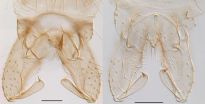A study published in the June issue of the journal Genetics characterized nearly 2000 variants of the breast cancer-associated gene BRCA1, demonstrating the potential of a new approach for sorting out which variants are harmful and which are harmless.
Because genetic tests increasingly use more comprehensive multi-gene and whole-genome sequencing methods, it's becoming more common for patients to learn they carry a variant of unknown significance. For example, a 2014 study showed 42 percent of breast cancer patients who received results from a 25-gene hereditary cancer genetic test carried a variant of unknown significance in one of the scanned genes.
'There's not much you can do with this information, except worry,' says lead author Lea Starita of the University of Washington. 'We hope to reduce some of the uncertainty by driving forward technologies for efficient functional testing of gene variants.'
The team used the BRCA1 gene as a test case for their approach because more is known about the functions and sequence variants of BRCA1 than many other genes associated with disease.
Normally, BRCA1 codes for a protein that regulates how the body repairs DNA mutations. People who carry a known pathogenic (disease-linked) BRCA1 variant have a higher risk of breast and ovarian cancers because the encoded protein is faulty; it fails to properly regulate DNA repair and allows cancer-causing mutations to accumulate.
But not all BRCA1 variants are pathogenic. Scientists can't usually tell whether a gene variant confers a higher disease risk until enough people with the variant have been identified to allow statistical analysis of their disease rates. For extremely rare or unique variants, such studies might never be possible.
To understand more about new or rare variants, the authors proposed an approach that doesn't directly examine disease risks, but instead measures the function of the gene's protein product. The encoded protein is tested with relatively simple laboratory assays that gauge whether the protein retains its normal biochemical functions. By performing many thousands of these tests at once, biologists can assess all possible variants of a gene quickly and efficiently. This method of performing protein function assays in a massively parallel format is called 'deep mutational scanning.'
Such laboratory tests are not perfect measures of whether or not a particular variant is functional. For example, proteins sometimes behave differently inside the human body than they do in a test tube, a laboratory organism, or a cell growing in a dish. But the large amounts of data generated by such experiments are still useful to researchers. For example, a database of functional information could help them to prioritize variants for more detailed studies, or to provide preliminary classifications of newly discovered variants.
In this study, the team combined data from two different tests of a key part of the BRCA1 protein called the RING domain. Around 58 percent of known pathogenic BRCA1variants affect this part of the protein. One of the tests measured the ability of the RING domain to attach small proteins called ubiquitin tags to other proteins. The second test measured whether the RING domain could bind to part of another protein called BARD1 when both proteins were produced in a yeast cell. If BRCA1 cannot bind to BARD1, it no longer prevents tumor formation. The data from both massively parallel assays were largely consistent with previous studies.
Combined scores from the massively parallel tests were also used to predict results from the so-called 'gold standard' of BRCA1 functional assays. This more comprehensive test assesses the full-length BRCA1 protein's ability to regulate DNA repair in cells, and is the measure that best correlates with disease risk in patients. The researchers found they could use data from the deep mutational scan to predict how a variant would perform in the gold standard test. The predictions made in this way were substantially more reliable than those made by widely-used computational methods that are currently used in genomic studies to predict the severity of mutations.
Starita cautions that although the results show remarkable promise, the data are not yet ready for use in the clinic. 'Clinicians can't use the data in isolation to make conclusions about a variant,' says Starita. 'Our model, based on experimental data, is a better predictor of the effects of mutations than those based on purely computational methods, but it is still not perfect.'
The team is working on related large-scale approaches for other genes. For example, many genetic variants linked to autism are located in genes that alter the packaging of DNA into a compact form called chromatin. The researchers are developing massively-parallel assays for chromatin remodeling that could be used to assess the function of many autism-associated variants.
The researchers are also using new genome editing technologies to create thousands of genetic variants directly in the genomes of cells growing in culture. These technologies would allow many other biochemical tests of protein function -- such as protein-protein interaction, enzyme catalysis, and protein stability -- to be performed at enormous scales, even for relatively poorly characterized genes.
'As genetic testing becomes both cheaper and more comprehensive, we will need a variety of approaches to translate the deluge of genetic data into practical information on individual health risks,' says Starita. 'Deep mutational scans are one tool to help meet this urgent need.'
INFORMATION:
Citation: Lea M. Starita, David L. Young, Muhtadi Islam, Jacob O. Kitzman, Justin Gullingsrud, Ronald J. Hause, Douglas M. Fowler, Jeffrey D. Parvin, Jay Shendure, and Stanley Fields (2015). Massively parallel functional analysis of BRCA1 RING domain variants. Genetics 200(2):413-422 doi: 10.1534/genetics.115.175802
http://www.genetics.org/content/200/2/413
About the Genetics Society of America (GSA)
Founded in 1931, the Genetics Society of America (GSA) is the professional scientific society for genetics researchers and educators. The Society's more than 5,000 members worldwide work to deepen our understanding of the living world by advancing the field of genetics, from the molecular to the population level. GSA promotes research and fosters communication through a number of GSA-sponsored conferences including regular meetings that focus on particular model organisms. GSA publishes two peer-reviewed, peer-edited scholarly journals: Genetics, which has published high quality original research across the breadth of the field since 1916, and G3:Genes|Genomes|Genetics, an open access journal launched in 2011 to disseminate high quality foundational research in genetics and genomics. The Society also has a deep commitment to education and fostering the next generation of scholars in the field. For more information about GSA, please visit http://www.genetics-gsa.org.

